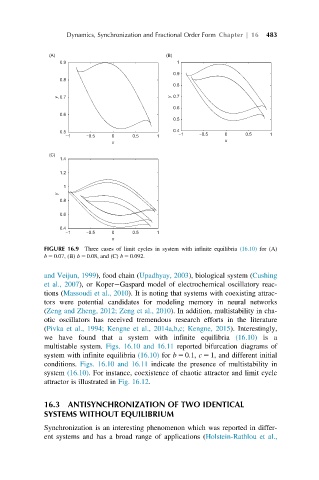Page 496 - Mathematical Techniques of Fractional Order Systems
P. 496
Dynamics, Synchronization and Fractional Order Form Chapter | 16 483
(A) (B)
0.9 1
0.9
0.8
0.8
y 0.7 y 0.7
0.6
0.6
0.5
0.5 0.4
−1 −0.5 0 0.5 1 −1 −0.5 0 0.5 1
x x
(C)
1.4
1.2
1
y
0.8
0.6
0.4
−1 −0.5 0 0.5 1
x
FIGURE 16.9 Three cases of limit cycles in system with infinite equilibria (16.10) for (A)
b 5 0:07, (B) b 5 0:08, and (C) b 5 0:092.
and Veijun, 1999), food chain (Upadhyay, 2003), biological system (Cushing
et al., 2007), or Koper Gaspard model of electrochemical oscillatory reac-
tions (Massoudi et al., 2010). It is noting that systems with coexisting attrac-
tors were potential candidates for modeling memory in neural networks
(Zeng and Zheng, 2012; Zeng et al., 2010). In addition, multistability in cha-
otic oscillators has received tremendous research efforts in the literature
(Pivka et al., 1994; Kengne et al., 2014a,b,c; Kengne, 2015). Interestingly,
we have found that a system with infinite equilibria (16.10) is a
multistable system. Figs. 16.10 and 16.11 reported bifurcation diagrams of
system with infinite equilibria (16.10) for b 5 0:1, c 5 1, and different initial
conditions. Figs. 16.10 and 16.11 indicate the presence of multistability in
system (16.10). For instance, coexistence of chaotic attractor and limit cycle
attractor is illustrated in Fig. 16.12.
16.3 ANTISYNCHRONIZATION OF TWO IDENTICAL
SYSTEMS WITHOUT EQUILIBRIUM
Synchronization is an interesting phenomenon which was reported in differ-
ent systems and has a broad range of applications (Holstein-Rathlou et al.,

